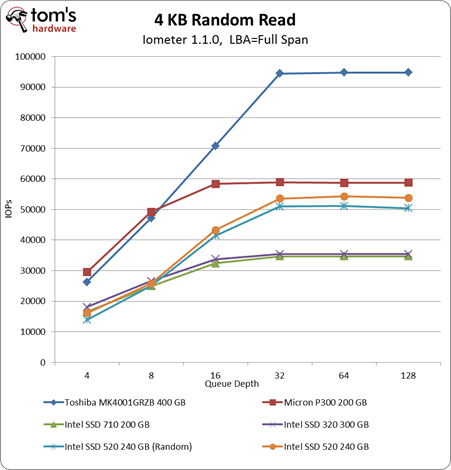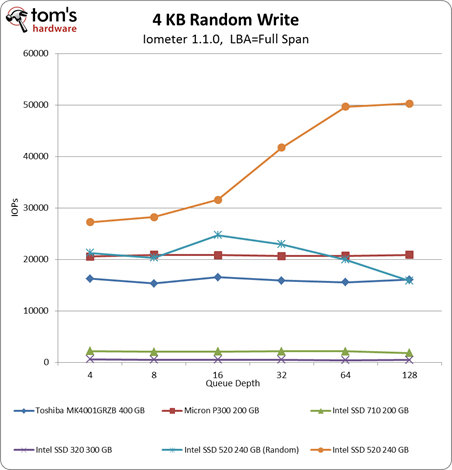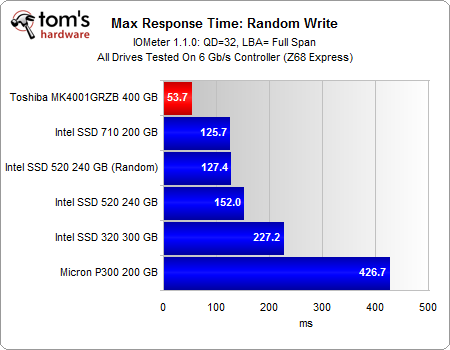Toshiba's $7000+ 400 GB SSD: SAS 6Gb/s, SLC Flash, And Big Endurance
Have you ever wondered what separates an enterprise SSD from a consumer-oriented drive? How about SLC and MLC flash (and a corresponding price gap)? We explore the differences with Toshiba's MK4001GRZB SSD, an obviously enterprise-oriented powerhouse.
4 KB Random Performance
Toshiba's MK4001GRZB is able to take full advantage of its SAS 6 Gb/s interface in this test, exceeding the performance of its SATA-based competition running at the same data rate. Presented with a queue depth of 32, performance starts to plateau at roughly 95 000 IOPS. The nearest competition is Micron's SLC-based P300, which starts higher than Toshiba's drive at lower queue depths, but falls just short of 60 000 IOPS with 16 outstanding commands or more.
Intel, the indisputable favorite amongst IT professionals shopping for enterprise-class SSDs, has a very driven focus on reliably. So much so, in fact, that its client-oriented drives are being used in certain server-based environments. So, we thought it'd be fitting to include SSD 320 and SSD 520 into our benchmarks for the sake of comparison. Interestingly, the company's SandForce controller-based drive achieves up to 50 000 IOPS using Intel's binned MLC flash. That falls shy of the P300, but it's a substantial improvement over the SSD 320 and more business-class SSD 710. And when we hit the drive with incompressible data, indicated by the light blue line marked Random, performance remains similar. The SandForce controller's reliance on compression for exceptional performance doesn't become a factor until we analyze write speed.
The MK4001GRZB has a rated random write speed of 16 000 IOPS at a queue depth of 16. According to our Iometer testing, that figure applies to all queue depths once the drive hits its steady state. In comparison, Micron's P300 performs much better, as it hits speeds just over 20 000 IOPS.
As an aside, Intel's SSD 520 really struts its stuff in this test thanks to SandForce's second-gen controller. At a queue depth of 64, the desktop-class SSD plateaus at speeds just over 50 000 IOPS.
Once we hit the steady state for 4 KB random I/O, the P300's average response time appears just slightly lower than Toshiba's MK4001GRZB, though the delta is only 25%.
Yet, in the same environment, peak response time measurements actually favor the SLC-based SSD. Going by the numbers, the max response time for the MK4001GRZB is 53.7 ms, which is almost 8x lower than the P300.
Although we don't mean to keep taking the emphasis off enterprise-class storage, we're again surprised by Intel's relatively new SSD 520. Depending on data type, the drive's maximum response time falls between ~125-155 ms. This puts the SSD 520 on par with Intel's SSD 710, and slightly better than its client-oriented SSD 320.
Get Tom's Hardware's best news and in-depth reviews, straight to your inbox.
Current page: 4 KB Random Performance
Prev Page Benchmarking For The Enterprise: A Whole New World Next Page 128 KB And 2 MB Sequential Performance-
compton Good job, Mr. Ku.Reply
Perhaps the Enterprise SSD Fairy will bring you a Hitatchi UltraStar with Intel's 6gbps controller. I'd be eager to see how it compares.
There is no substitute for SLC though. -
bennaye nebun$7000 any company willing to pay this much for an SSD is fullishReply
...fullish of cash? Definitely. Foolish? Probably not.
-
nebun bennaye...fullish of cash? Definitely. Foolish? Probably not.damn the english language.....there are way to many words that sound alikeReply -
nitrium Why is the 4KB Random read/write performance shown as IOPS, but 128KB and 2MB performance is in MB/sec? What speed (in MB/sec) does this drive achieve in 4KB? I guess I could calculate it from (IOPS * 4KB) / 1024 (I think that's right), but why should I have to?Reply -
spazoid amdfreakIt is too expensive for the performance it offers. You can get a RAID array of many Intel SSDs beating Toshiba in every segment.Reply
You've clearly not understood the purpose of this article. Stick to commenting the desktop drive reviews in the future, please.
Thank you for this review, and especially your estimations on the endurance of the drive. It's something that's damn near impossible for us IT professionals to get accurate estimations of in the real world. For some reason, bosses tend to want the expensive hardware to be put to use instead of being thoroughly tested.
More of these types of articles please! :] -
@spazoid, so you are telling me that you are willing to pay 10x for an endurance of 3x over the INTEL 520 SSD?Reply
Even when the INTEL SSD already has an endurance longer than your refresh cycle for your tech stack?
-
EJ257 frozonicLOL, i can just imagine myself in ten years telling my kids that we had to pay 7000$ for a 400gb ssd...by that time we are gonna have 400+ TB ssdsReply
"Back in my days storage drives used to have moving parts. Now its all solid state." -
jaquith I own a small data center and thankfully have access to a 'major' financial institutions test data, and I agree with your conclusions especially regarding deployment into production. $7K SSD is a tough call with a 5-year, but if it were 7~10-year then probably an easy call.Reply
Unlike super-sized enterprise which I am not, the cost/benefit calculations would be difficult for myself. I know firsthand the money that i.e. financial institutions push into their data centers, and for those folks $7K isn't out of the question.
Interesting SSD and if the prices come down and warranty extended then IMO it would be something to consider and compare against Intel's products.



